Apple growing in Florida was once limited to northern areas where a few local selections of medium to poor quality were grown (Figure 1). These selections fruited well only after the coldest winters. Northern apple cultivars such as 'Red Delicious', 'Golden Delicious', and 'McIntosh' do not produce well in Florida. The main problem is that these selections receive insufficient cold during the winter and, therefore, are slow and weak growing and fruit poorly when grown in Florida.
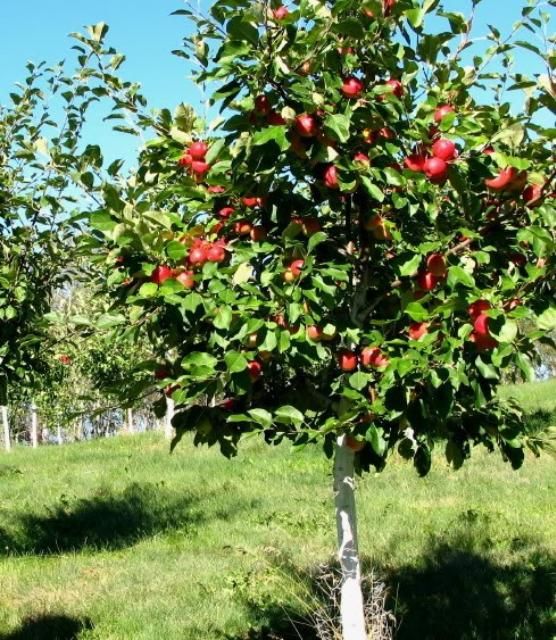
Credit: B. Hanlin (North Carolina State University)
However, apple varieties have been grown and fruited in Leesburg, Gainesville, and Quincy. 'Anna' (Figure 2), 'Dorsett Golden' (Figure 3), 'Tropic Sweet' (Figure 4), and 'Ein Shemer' (Figure 5) appear best adapted to conditions in these areas. They have a cold requirement in the range of 300 to 400 hours below 45°F.
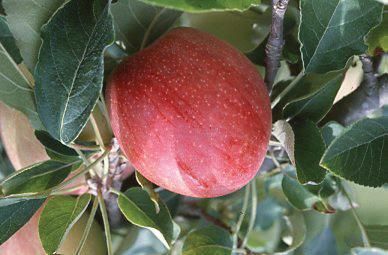
Credit: UF/IFAS North Florida Research and Education Center
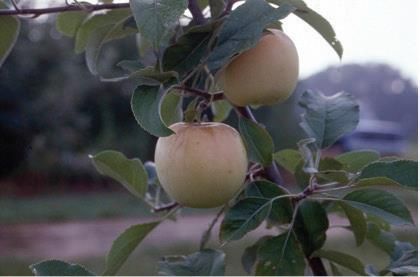
Credit: UF/IFAS North Florida Research and Education Center
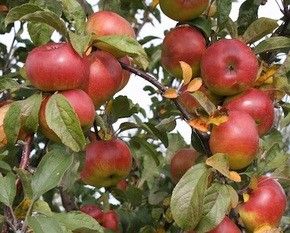
Credit: http://www.heritagefruittrees.com.au
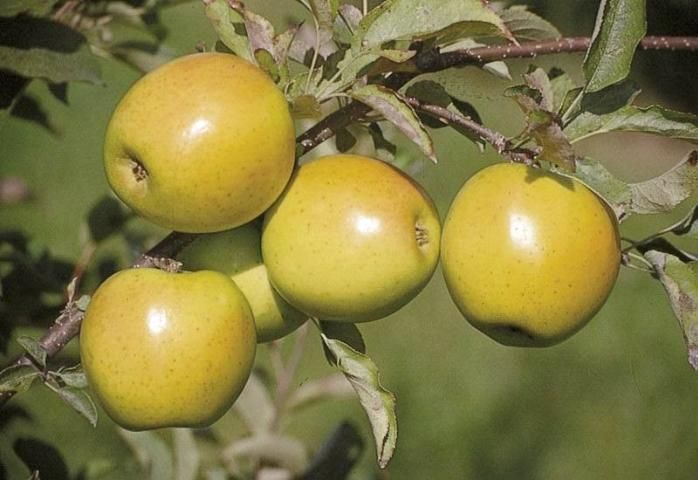
Credit: http://www.heritagefruittrees.com.au
Varieties
'Anna' and 'Ein Shemer' were obtained from Israel in 1967. These varieties fruit and leaf well in central Florida. Fruit ripens at Gainesville in late June to early July. Fruit sizes range from 2 to 2½ inches in diameter for 'Anna' and up to 2¾ inches for 'Ein Shemer'. 'Anna' has a shape similar to 'Red Delicious', but with approximately 30% to 40% red blush. Their flavor is good and is sweet to semiacid. Ripe fruit of 'Ein Shemer' is similar in shape and yellow with a sweet flavor.
'Dorsett Golden' was introduced from Nassau, Bahamas, and obtained in Gainesville from R.J. Knight of the Plant Introduction Station in Miami. Fruit is yellow with a 10% slightly pink blush, and size is 2 to 2¼ inches. Flavor is sweet. 'TropicSweet' (Fla. 90-3) is released by the Florida Agricultural Experiment Station and patent rights assigned to Florida Foundation Seed Producers, Inc. for distribution. This variety originated as [(N.J.38 x Anna) polycross]. 'TropicSweet' blooms with 'Anna', but ripens five to seven days before, and during early June in Gainesville, Florida. Trees of 'TropicSweet' are not self-fruitful but are cross-pollinated with either 'Anna' or 'Dorsett Golden'. Fruit is less red, firmer, and tastes sweeter than 'Anna'. Fruit sugar levels are 14 to 15 brix, but acidity in fruit is low, resulting in a very sweet taste. Fruit size is similar to 'Anna' with comparable crop loads. Fruit is round-conic. Trees are semi-spreading and semi-spur-type bearing habit. 'TropicSweet' is recommended for trial in areas where 'Anna' is grown successfully (north central to central Florida has proven most reliable for 'Anna'). For more information on apple varieties for Florida, please visit EDIS publication Low-Chill Apple Cultivars for North Florida and North Central Florida, https://edis.ifas.ufl.edu/mg368.
Local apple selections also are planted in Florida. These have been grown, selected, and propagated in different geographic locations in the north Florida area. Their quality often is good, but production is erratic and fruit is generally small.
Pollination
Most apples are self-unfruitful and require cross-pollination for adequate fruit set. Partial pollination will often result in a fruit containing one to two seeds (Figure 6). Most of the fruit that have only a few seeds and those in which embryo abortion occurs will drop before maturity. 'Anna' and 'Dorsett Golden' overlap at bloom in Gainesville. Thus, it is recommended that the two cultivars be planted together for good cross-pollination.

Credit: Fir0002, https://en.wiktionary.org
Propagation and Planting
Apple cultivars are not true to type when grown from seed. Therefore, growers are advised to obtain known cultivars grafted on suitable rootstock.
For a home orchard, apple trees can be planted in a variety of soil types. However, they grow best if planted in a fertile sandy loam soil with deep drainage. Select a site that allows for good air drainage to reduce frost damage to fruit in the late spring.
One to two-year-old healthy bare-root trees obtained from a nursery should be planted without allowing the roots to dry. Apple trees may be planted any time during the dormant season, but the period from late December to February is best because this allows time for the roots to become established before spring growth begins. Trees purchased in containers can be planted at just about any time of the year provided adequate water is applied. Water should be applied through the dry spring months and other dry periods.
Planting holes should be large enough to ensure that the root system is neither crowded nor bent. Extra-long or broken roots should be pruned before planting. The plant should be placed in an upright position in the hole and planted at approximately the same depth it was in the nursery. Put a small amount of soil into the hole and pack it around the roots, then repeat this procedure until the hole is full of soil and the plant is firmly in place. After planting, make a soil ring around the edges of the hole to form a reservoir for water. This reservoir then should be completely filled with water in order to settle the soil around the roots. Do not fertilize at planting.
Cultivation
Cultivation is usually necessary only for weed control and should be done as shallow as possible to avoid damage to the root system. An area approximately two feet from the trunk of the tree should be maintained in a weed-free condition. Chemical weed killers are usually impractical for home use. Mulches may be used to control weeds and conserve moisture.
Fertilization
Fertilizer requirements for apple trees are largely unknown for Florida conditions. A balanced fertilizer such as 10-10-10 or similar mixture is recommended. About one pound of this mixture for each year of the tree's age is applied yearly until a maximum of 15 pounds per year is reached. The fertilizer should be applied in two doses with one half of the fertilizer in each application. The first application should be made during the dormant period in January and another application at the beginning of the rainy season in June. The fertilizer should be broadcasted evenly beneath the tree.
Irrigation
The amount of water and when to apply it depends not only on frequency and amount of rainfall, but also on soil type. More frequent irrigation will be required on sandy soils than on clay or organic soils. The area beneath the canopy of the tree should be wet to a depth of several feet at each irrigation, which may require more than 50 gallons of water per tree for large trees or as little as 5 to 10 gallons for young trees. Irrigation may be required every 7 to 10 days under extremely dry conditions.
Pruning
Young apple trees should be pruned to a modified leader system. On two-year-old trees, five or six strong scaffold limbs should be selected to develop a strong framework. These limbs should have wide angles almost perpendicular to the trunk of the tree and should be radially spaced around the tree trunk and vertically spaced approximately 6" to 8" from each other up or down the trunk. Later pruning of the tree will be needed to remove diseased or dead wood and to trim the tree to the desired shape.
Harvesting and Storage
Apples ripen satisfactorily on the tree (Figure 7). They should be picked when they have reached optimum size and color. Immature fruit will also ripen with satisfactory quality in a refrigerator. 'Ein Shemer' fruit tends to become mealy if overripe. It does not store more than two weeks even under refrigeration. Fruit of 'Anna' have been held under refrigeration satisfactorily for six to eight weeks.
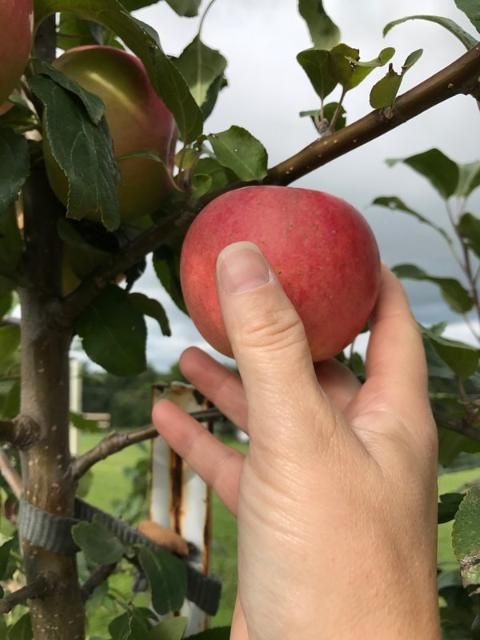
Credit: Dittmar Farms and Orchards (http://www.dittmarfarms.com/)
Pest Control
Preventive control of pests is required to maintain healthy trees and good fruit quality. Contact your UF/IFAS county Extension office for current pest control recommendations.
Apple Scab
This fungus affects leaves, flowers, and fruit. Lesions develop on both leaf surfaces causing leaf distortion. Scabby dark spots are clearly seen on infested fruit. As the fruit matures in regions having a warm climate, the spot commonly appears as russeted scars (Figurer 8).. Previous infection of immature fruit results in cracking and distortion of the area associated with scab lesions. Efficient control of apple scab may be achieved by fungicide applications.
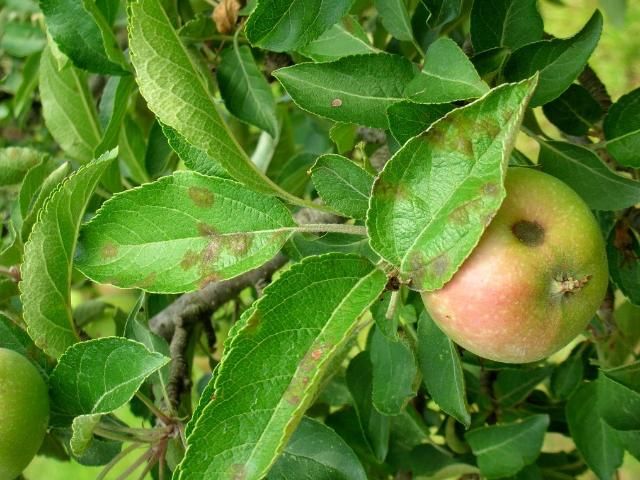
Credit: J. Beckerman (Purdue University)
Fire Blight
This bacterial disease spreads from tree to tree primarily during the spring. It can generally be controlled by reducing nitrogen fertilizer which results in over vigorous growth (Figure 9). When infection is present, the infected area should be pruned out, cutting at least 8" to 10" below the lowest visible infection. The pruned-off limbs then should be burned.
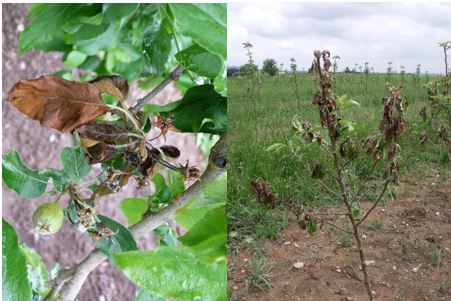
Credit: K. Peter (Penn State University)
Bitter Rot
This fungus infects only the fruit. It starts as a small, circular, light brown area. Spots enlarge rapidly and become darkened (Figure 10). A distinctive characteristic is a saucer-shaped depression with fruiting structures in the center and concentric rings to the periphery.
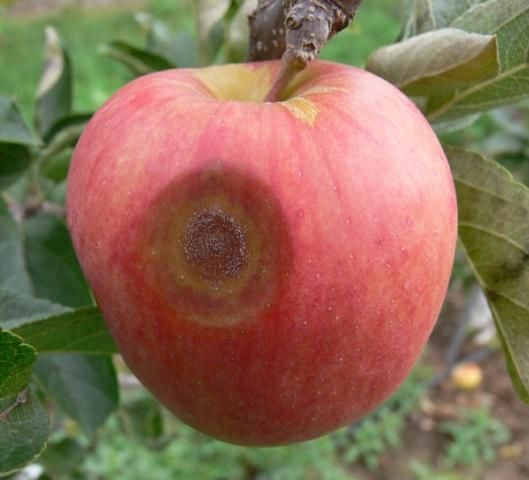
Credit: Ontario Ministry of Agriculture, Food and Rural Affairs
Scale Insects
Several scale insects may infest leaves, twigs, branches, or fruit.
Rabbit Control
Rabbits eat the bark of apple trees during the winter months and can kill the tree by girdling the trunk. For best control, a physical barrier such as hardware cloth or plastic tree guards should be placed around the trunk of the tree. Rabbits will also feed on prunings in preference to young trees.